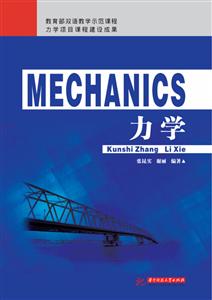預估到手價是按參與促銷活動、以最優惠的購買方案計算出的價格(不含優惠券部分),僅供參考,未必等同于實際到手價。
-
>
闖進數學世界――探秘歷史名題
-
>
中醫基礎理論
-
>
當代中國政府與政治(新編21世紀公共管理系列教材)
-
>
高校軍事課教程
-
>
思想道德與法治(2021年版)
-
>
毛澤東思想和中國特色社會主義理論體系概論(2021年版)
-
>
中醫內科學·全國中醫藥行業高等教育“十四五”規劃教材
力學 版權信息
- ISBN:9787568035545
- 條形碼:9787568035545 ; 978-7-5680-3554-5
- 裝幀:一般膠版紙
- 冊數:暫無
- 重量:暫無
- 所屬分類:>>
力學 本書特色
本書是教育部、財政部聯合批準的g家級雙語教學示范課程——力學課程英文版教材建設的成果。本書根據我國現行高等院校物理專業力學課程教學大綱編寫,包括十二章內容:質點運動學、牛頓運動定律、動量、動能和勢能、角動量、萬有引力定律、剛體力學、彈性體的應力與應變、流體力學、振動、波動和聲、狹義相對論。 本書抓住國際、國內優秀物理學教材的編寫特點編寫,結構清晰、簡明扼要。本書加強了力學與現代科技、日常生產和生活及其他學科的聯系,努力將計算物理的方法融入力學課程教學之中。 本書可作為高等院校本科物理類專業力學課程的雙語教材,也可供相關專業師生參考。
力學 內容簡介
Abstract This English version Mechanics is the product of the curriculum construction of the ‘National Bilingual Teaching Demonstration Course’ -- Mechanics, approved by the Ministry of Education of China and the Ministry of Finance of China. This textbook is based on the current syllabus of Mechanics course for the students majoring physics. The content of this textbook covers twelve chapters: kinematics, Newton’s laws of motion, momentum, mechanical energy, angular momentum, gravitation, rigid body, elasticity, fluids, oscillations, waves, special theory of relativity. This textbook focuses on absorbing and utilizing writing characteristics from both foreign and domestic popular Physics textbooks. The structure of this book is clear and the teaching materials are presented to be concise and to the point. This book reinforces the close links between Mechanics and modern science and technology, daily production, daily life and other subjects, and strives to integrate computational physics into the process of the teaching of Mechanics course. This book can be used as the textbook for bilingual teaching of Mechanics course for the undergraduate students who majoring physics (or physics-related specialty) in universities and colleges, and it is also available for reference by other teachers and students. 內容簡介 本書是教育部、財政部聯合批準的g家級雙語教學示范課程——力學課程英文版教材建設的成果。本書根據我國現行高等院校物理專業力學課程教學大綱編寫,包括十二章內容:質點運動學、牛頓運動定律、動量、動能和勢能、角動量、萬有引力定律、剛體力學、彈性體的應力與應變、流體力學、振動、波動和聲、狹義相對論。 本書抓住國際、國內優秀物理學教材的編寫特點編寫,結構清晰、簡明扼要。本書加強了力學與現代科技、日常生產和生活及其他學科的聯系,努力將計算物理的方法融入力學課程教學之中。 本書可作為高等院校本科物理類專業力學課程的雙語教材,也可供相關專業師生參考。
力學 目錄
Chapter 1 Kinematics of Particles……………………………………………………………...1
1.1 Reference Frame and Particle Model………………………………………............................2
1.2 Kinematical Equation of a particle…………………………………………………………….3
1.3 Instantaneous Velocity and Instantaneous Acceleration……………………………………...5
1.4 Rectilinear motion…………………………………………………………………………...10
1.5 Projectile Motion…………………………………………………………………………….14
1.6 Curvilinear Motion…………………………………………………………………………..20
1.7 Relative Motion and Galilean transformation…………………………………………………………...26
Review & Summary ……………………………………………………………………………..…………
Discussion Questions ……………………………………………………………………………..…………
Problems ……………………………………………………………………………..………………………
Chapter 2 Newton’s Laws of Motion………………………………………………………….
2.1 Newton’s Laws of Motion …………………………………………………………………………...
2.2 General Forces Encountered in Everyday Life ………………………………………………………...
2.3 Applications of Newton’s Laws of Motion ………………………………………………………….
2.4 Non-inertial Frames and inertial Forces ………………………………………………………………..
*2.5Numerical integration ……………………………………………………………………………..
Review & Summary ……………………………………………………………………………..…………
Discussion Questions ……………………………………………………………………………..…………
Problems ……………………………………………………………………………..………………………
Chapter 3 Momentum………………………………………………………………………….
3.1 Momentum and Newton’s Second Law of Motion……………………………………………………….
3.2 Impulse and the Impulse-Momentum Theorem………………………………………………………..
3.3 Center of Mass and Kinetic Theorem of the Center of Mass…………………………………………………..
3.4 The Law of Conservation of Momentum……………………………………………………………………
3.5 The Motion of Rocket……………………………………………………………………………………….
Review & Summary ……………………………………………………………………………..…………
Discussion Questions ……………………………………………………………………………..…………
Problems ……………………………………………………………………………..………………………
Chapter 4 Work and Energy…………………………………………………………………..
4.1 Work……………………………………………………………………………………………………
4.2 The work-kinetic energy theorem……………………………………………………………………....
4.3 Conservative force, nonconservative force and potential energy……………………………………………
4.4 The law of conservation of mechanical energy…………………………………………………………..
4.5 Collisions……………………………………………………………………………………………...
Review & Summary ……………………………………………………………………………..…………
Discussion Questions ……………………………………………………………………………..…………
Problems ……………………………………………………………………………..………………………
Chapter 5 Angular momentum……………………………………………………………….
5.1 Angular momentum of a particle with respect to a reference point ……………………………………...
5.2 Angular momentum of a particle with respect to a fixed axis ………………………………………………..
5.3 Angular momentum of a system of particles……………………………………………………………...
Review & Summary ……………………………………………………………………………..…………
Discussion Questions ……………………………………………………………………………..…………
Problems ……………………………………………………………………………..………………………
Chapter 6 Gravitation………………………………………………………………………...
6.1 Kepler’s Laws………………………………………………………………………………
6.2 Newton’s Law of Universal Gravitation……………………………………………………………....
6.3Gravitational Field and Satellite Motion……………………………………………………………...
6.4Gravitational Potential Energy and Three Cosmic Velocities………………………………………..
Chapter 7 Mechanics of Rigid Bodies……………………………………………………….
7.1 Classification of the Motion of Rigid Bodies…………………………………………………………
7.2 Translational Motion and Theorem of Motion of COM…………………………………………………...
7.3 Rotation of Rigid Body about a Fixed Axis………………………………………………………………..
7.4 Rotational Inertia Calculations…………………………………………………………………..
7.5 Angular Work-kinetic Energy Theorem and
Moment of Impulse-angular Momentum Theorem……………………………………………………………
7.6 Plane-parallel Motion of Rigid Bodies………………………………………………………………..
7.7 Equilibrium of Rigid Bodies…………………………………………………………………….
7.8 Procession of a Gyroscope………………………………………………………………………
Review & Summary ……………………………………………………………………………..…………
Discussion Questions ……………………………………………………………………………..…………
Problems ……………………………………………………………………………..………………………
Chapter 8 Fluid Mechanics…………………………………………………………………..
8.1 Static hydrodynamics ……………………………………………………………………………………..
8.2 Motion of an idea fluid……………………………………………………………………………………..
8.3 Bernoulli’s Equation…………………………………………………………………………………..
8.4 Motion of viscous fluid…………………………………………………………………………………….
Review & Summary ……………………………………………………………………………..…………
Discussion Questions ……………………………………………………………………………..…………
Problems ……………………………………………………………………………..………………………
Chapter 9 Elasticity………………………………………………………………………...
9.1Tensile and Compressive Deformation of Elastic Body……………………………………………………...
9.2 Shearing Deformation of Elastic Body…………………………………………………………………….
9.3 Bending and Twisting Deformation……………………………………………………………………………
Review & Summary ……………………………………………………………………………..…………
Discussion Questions ……………………………………………………………………………..…………
Problems ……………………………………………………………………………..………………………
Chapter 10 Oscillations………………………………………………………………………...
10.1 Simple harmonic motion……………………………………………………………………………...
10.2 Comparing SHM with UCM………………………………………………………………………….
10.3 Energy in simple harmonic oscillator…………………………………………………………………
10.4 Combination of SHM…………………………………………………………………………………
10.5 Damped oscillation……………………………………………………………………………………
10.6 Forced oscillation and resonance…………………………………………………………………………..
Review & Summary ……………………………………………………………………………..…………
Discussion Questions ……………………………………………………………………………..…………
Problems ……………………………………………………………………………..………………………
Chapter 11 Wave Motion and Sound Waves……………………………………………….
11.1 Basic concept of waves…………………………………………………………………………………..
11.2 Mathematical description of a wave………………………………………………………………………..
11.3 Wave equation and wave speed…………………………………………………………………………..
11.4 Energy of waves………………………………………………………………………………………….
11.5 Huygens principle, Reflection and Diffraction of waves…………………………………………………
11.6 Superposition and Interference……………………………………………………………………………
11.7 Standing waves………………………………………………………………………………………
11.8 Sound waves………………………………………………………………………………………………
11.9 The Doppler Effect………………………………………………………………………………………..
Review & Summary ……………………………………………………………………………..…………
Discussion Questions ……………………………………………………………………………..…………
Problems ……………………………………………………………………………..………………………
Chapter 12 Special Theory of Relativity…………………………………………………
12.1 The Background of the Birth of the Special Theory of Relativity………………………………………….
12.2 Einstein’s Postulates of Relativity and the Lorentz Transformations Equations………………………..
12.3 The Space-Time Theory of Relativity……………………………………………………………………..
12.4 The Velocity Transformation of Relativity………………………………………………………….
12.5 Relativistic Momentum and Relativistic Energy……………………………………………….………
12.6 Introduction to the General Theory of Relativity ……………………………………………………..
Review & Summary ……………………………………………………………………………..…………
Discussion Questions ……………………………………………………………………………..…………
Problems ……………………………………………………………………………..………………………
力學 作者簡介
張昆實 謝麗,高校教師,從事專業教學數十年,教學經驗豐富。
- >
唐代進士錄
- >
企鵝口袋書系列·偉大的思想20:論自然選擇(英漢雙語)
- >
史學評論
- >
回憶愛瑪儂
- >
新文學天穹兩巨星--魯迅與胡適/紅燭學術叢書(紅燭學術叢書)
- >
羅曼·羅蘭讀書隨筆-精裝
- >
月亮與六便士
- >
二體千字文















